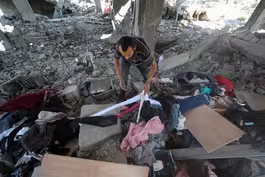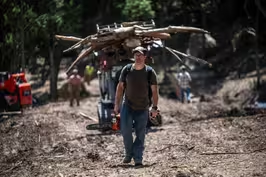
July 13, 2025 - PBS News Weekend full episode
7/13/2025 | 26m 45sVideo has Closed Captions
July 13, 2025 - PBS News Weekend full episode
July 13, 2025 - PBS News Weekend full episode
Problems playing video? | Closed Captioning Feedback
Problems playing video? | Closed Captioning Feedback
Major corporate funding for the PBS News Hour is provided by BDO, BNSF, Consumer Cellular, American Cruise Lines, and Raymond James. Funding for the PBS NewsHour Weekend is provided by...

July 13, 2025 - PBS News Weekend full episode
7/13/2025 | 26m 45sVideo has Closed Captions
July 13, 2025 - PBS News Weekend full episode
Problems playing video? | Closed Captioning Feedback
How to Watch PBS News Hour
PBS News Hour is available to stream on pbs.org and the free PBS App, available on iPhone, Apple TV, Android TV, Android smartphones, Amazon Fire TV, Amazon Fire Tablet, Roku, Samsung Smart TV, and Vizio.
Providing Support for PBS.org
Learn Moreabout PBS online sponsorshipJOHN YANG: Tonight on PBS News Weekend, the search for victims in the Texas hill countries interrupted by heavy rain as officials warn of a renewed threat of flash flooding.
Then, how Russia used Brazil as a launching pad for Vladimir Putin's deep cover operatives around the world.
And from New York to Seattle and across the globe, why some of the world's most populous cities are slowly sinking.
MAN: In a place like Mexico City, up to 20 inches a year of sinking.
In the United States, it's a little bit less, but it's still the sort of slow motion crisis that's across the country.
(BREAK) JOHN YANG: Good evening.
I'm John Yang.
A new round of heavy rains and a renewed threat of flooding in central Texas today interrupted the search for those still missing from the devastating Fourth of July flash floods.
Ten days after the fast moving waters of the Guadalupe River swept away homes and vehicles, the full extent of the human toll is still emerging.
The death toll has risen to nearly 130, with more than 170 people still unaccounted for.
Tony Plohetski is a reporter with the Austin American-Statesman and Austin television station KVUE.
Tony, what are conditions like right now and any indication of when searchers will be able to get back to work?
TONY PLOHETSKI, The Austin American-Statesman: John, we have had flash flood warnings throughout the region all afternoon as bands of heavy rain and thunderstorms move through this area.
Of course, everyone is looking to the sky, given what happened here about 10 days ago.
But as we with regard to the rescue, as we know it was halted earlier this morning due to that flooding threat, that continued flooding threat.
But officials say they are prepared to begin resuming the search for possible victims of this flooding as early as late today and definitely overnight and first thing tomorrow on Monday.
JOHN YANG: As that search goes on, is there a possibility that some victims may never be found?
TONY PLOHETSKI: John that is the grim reality that many families are beginning to confront.
Given the fact that now the search has gone on for so many days.
There are emerging conversations, particularly for example in the legal community here in Austin about what that can mean with regard to possibly obtaining death certificates, settling the estates of some of the victims of the flood.
John, I'm told that soon after 9/11, the Texas legislature actually put a new law in place that would allow loved ones and families of victims of natural disasters to obtain death certificates within 10 days of a disaster similar to the one that unfolded here.
JOHN YANG: And talk about the process of what our officials are doing to identify those who have been found.
TONY PLOHETSKI: John, this is a very difficult task.
What I'm told is that local justices of the peace in Kerr County have relied on a number of ways to try to identify victims of the flood, including visual determination of some of the victims.
At the same time, though, we know that autopsies have been ordered for some of them and their bodies have been taken to both medical examiners offices, Travis county here in Austin as well as Bexar County in San Antonio.
John, we're told that in addition to that, authorities are also relying upon rapid DNA that they are actually sending for testing at the University of North Texas, that's outside of Dallas, to try to verify and confirm the identities of some of the victims before releasing them to their families for funeral services.
JOHN YANG: And speaking of the funeral services, I understand they are underway funerals and memorial services.
I know you've spoken to people who've lost family members and other loved ones.
Tell me about that those conversations.
TONY PLOHETSKI: As you can imagine, particularly with parents who have lost their young children, the grief is just unimaginable.
The fact that there are so many funerals happening across the state right here in Austin, we know that a number of young girls died at Camp Mystic.
This tragedy has impacted people that I know that my family knows directly.
So I think of Lenny McCowen who died alongside her best friend at Camp Mystic, Abby Pole.
I've been in touch with the parents of both of them.
I also think of Mary Stevens, who was an 8-year-old who also died at Camp Mystic.
And so the families are of course continuing to grieve, as is the entire community and by now knows of all of their stories.
JOHN YANG: Tony Plohetski with some heartbreaking details from Austin, Texas.
Thank you very much.
TONY PLOHETSKI: Thank you.
JOHN YANG: In today's other news, Israeli strikes in Gaza today killed at least 32 people.
One of the strikes was on a water collection point where 10 people died, six of them children.
The Israeli military said the site was not the intended target but the missile malfunction.
Strikes also hit a home in central Gaza where nine people died and a group of people walking along a Gaza city street killing 11, including a surgeon on his way to work.
Gaza officials say the Palestinian death toll so far in 21 months of war has surpassed 58,000.
And in the occupied west bank, funerals were held for two Palestinians killed by settlers this past week, including U.
S born Palestinian American Sayfollah Musallet.
Two wildfires near the Grand Canyon are growing rapidly, fueled by hot, dry winds.
Park officials said a historic lodge on the North Rim was destroyed along with the visitor center, a gas station and a wastewater treatment plant.
The burning plant released chlorine gas, forcing firefighters to evacuate.
The European Union says it's holding off on retaliatory tariffs on U.S. goods in the hopes of reaching a trade deal by August 1st.
That's the day new 30 percent U.S. tariffs against the E.U.
and Mexico are to take effect.
On ABC's this Week, white House economic adviser Kevin Hassett said President Trump doesn't like the draft trade deals he's seen so far.
KEVIN HASSETT, Director, National Economic Council: Well, these tariffs are real if the president doesn't get a deal that he thinks is good enough but, you know, conversations are ongoing and we'll see where the dust settles.
JOHN YANG: Among the major products the United States buys from Europe are cars, pharmaceuticals and wine.
And at Wimbledon, world number one Jannik Sinner beat two time defending champion Carlos Alcaraz to win the men's title.
It's Sinner's first Wimbledon win and fourth Grand Slam title.
Alcaraz had won the previous five head to head matches between the two rivals, including an epic final in June at the French Open.
Still to come on PBS News Weekend, how Russia used Brazil as a spy factory for global espionage and the controversy around the Florida detention center called Alligator Alcatraz.
(BREAK) JOHN YANG: They seemed like ordinary Brazilians, starting businesses, building friendships, having romantic relationships.
They even had legitimate Brazilian birth certificates and passports.
But in reality, there were Russian intelligence agents leading double lives.
A New York Times investigation found that Moscow used Brazil as a launch pad for its global espionage operation.
Brazilian federal police uncovered the deception after a years long hunt dealing a massive blow to Vladimir Putin's spy program.
Ali Rogin recently spoke with New York Times reporters Michael Schwirtz and Jane Bradley.
ALI ROGIN: Thank you so much for joining me.
Jane, first to you.
What was it about the country of Brazil that made it so that Russia could base and train these deep cover operatives there?
JANE BRADLEY, The New York Times: The sources we spoke to in Brazil said a few things.
The first is that, you know, Brazil is known for being a very multicultural, diverse population, so it's easy for anyone, including a Russian spy, to blend in.
The second was that Brazilian passports are pretty powerful.
They're useful.
They get you into a lot of countries visa free.
So it was a really powerful tool to have for a Russian spy.
And then finally, and this is a more complex point, but there's a certain weakness in the Brazilian birth certificate or ID system, which makes it a really attractive target for a Russian.
ALI ROGI: So, Michael, these spies who were able to create this Persona and provide a backstory, Tell us about them.
They're called illegals.
That's how the Russian intelligence service refers to them.
They live and work in Brazil, and then what happens?
Russia intends to send them around the world to conduct operations.
MICHAEL SCHWIRTZ, The New York Times: You're right.
These individuals were not sent to Brazil to spy on Brazil necessarily.
They were meant to become Brazilian, and then they were to be sent out into the world to engage in the actual craft of espionage.
So we have some who were sent to Portugal.
We have another who got an internship in the Netherlands at The Hague, at the International Criminal Court.
Another was sent to the Middle East.
And the whole point of this program is to basically launder the identities so that anybody looking into their background will find only Brazilians.
ALI ROGIN: Jane, one of the people your investigation focuses on, his name, his Brazilian identity was Gerhard Daniel Campos Wittich.
Who was he known as in Brazil, and who was he really?
JANE BRADLEY: Yeah.
So out of all the nine spies we looked at, he'd probably built the most impenetrable cover identity.
He had built a bonafide 3D printing business he had in Rio.
He had a Brazilian girlfriend who knew nothing of his real identity.
He lived in a nice apartment in a nice part of Rio.
They had a cat together.
He built friendships.
The people who knew him described him as someone who was quite shy, quite reserved, and was very afraid or disliked having his photo taken.
That was one of the things they thought was strange only in hindsight.
But outside of painting a picture of this workaholic who really seemed to care about the business, they didn't know much about Daniel.
And that is because, you know, Daniel wasn't his real name.
His real name, we discovered, is Artem Shmyrev.
And he secretly had a Russian wife who was also an intelligence officer posted in Greece.
What was really interesting as part of our investigation that we uncovered was this kind of this cache of text messages between Artem and his Russian wife.
In these texts, he's basically complaining about his lot and saying he's not where he wanted to be at this time.
In his life, he wasn't really getting any real results at work.
And his wife says, look, this is what you make of it.
If you wanted an ordinary family life, you've made the wrong choice.
And kind of tells him to get a grip.
Though she acknowledges that, look, the life they're living as these deep cover spies is not, in her words, what they were sold when they signed up to it.
She said they basically trick people into it.
ALI ROGIN: Unbelievable.
Michael, how did this firing unravel?
MICHAEL SCHWIRTZ: Well, it started in about spring 2022 with a tip from the CIA to the Brazilian Federal Police.
And what this tip was a warning that an individual with a Brazilian passport was flying into Sao Paulo from the Netherlands.
The name of the passport was Victor Muller Ferreira.
This individual's actual name was Sergey Cherkasov, and he was an officer with Russia's military intelligence service.
And once they arrested him and got him their headquarters, and under questioning, he was very cocky because he had a really airtight cover story.
His passport was authentic.
He had driver's license.
He had a certificate declaring that he had completed his.
His required military service.
He had a voter registration card, and he had this birth certificate.
And this turned out to be really the linchpin in the investigation.
As the police started looking into his birth certificate, they found family members of the woman he had named as his mother.
And when they interviewed this woman's family, they discovered that she had never had a child.
And that was the first break in the case.
And so they began this sort of colossal task of pouring over really, millions of identity documents looking for a similar pattern, somebody who had come to Brazil late in life as an adult, claiming a birth certificate and who immediately set out collecting all these other documents.
This search over three years turned up nine names and all of them were outed by the Brazilian authorities in what was a colossal blow to Vladimir Putin's spy program.
ALI ROGIN: Fascinating stuff.
Michael Schwirtz and Jane Bradley with the New York Times, thank you so much.
MICHAEL SCHWIRTZ: Thanks for having us.
JOHN YANG: This weekend, lawmakers got their first look inside Alligator Alcatraz, the makeshift immigration detention center in the Florida Everglades.
Florida Democrat Debbie Wasserman Schultz called the conditions disturbing and vile.
REP. DEBBIE WASSERMAN SCHULTZ (D) Florida: This is an appalling, outrageous environment to detain anyone.
This place needs to be shut the hell down.
It needs to be shut down.
JOHN YANG: On NBC's Meet the Press this morning, Homeland Security Secretary Kristi Noem challenged that description.
KRISTI NOEM, Department of Homeland Security: I wouldn't call them jail cells.
I would call them a facility where they are held and that are secure facilities but are held to the highest levels of what the federal government requires.
JOHN YANG: Miami Herald reporter Ana Ceballos is covering the controversy surrounding Alligator Alcatraz.
Ana, just this morning you and your colleagues at the Miami Herald and the Tampa Bay Times published a list about 700 names of detainees who are either at Alligator Alcatraz are scheduled to be sent there.
What's the significance of what you found on that list?
ANA CEBALLOS, The Miami Herald: So the importance of that list is really being able to identify who is in there.
What are their criminal records?
We found that at least more than two hundred and fifty people do not have a criminal conviction or criminal charge pending, but they are there instead for immigration violations.
JOHN YANG: And did you ask the government about that last fact that they don't have charges?
Because the administration has been saying these are the worst of the worst, the evil of the evil?
ANA CEBALLOS: I did.
We shared this list before publication with the Department of Homeland Security as well as with the Florida Division of Emergency Management, which been identified as the state agency that is operating the site.
We did not hear from the state agency, but we did hear from the Department of Homeland Security.
And they said that just because individuals show that they do not have a criminal history does not mean that they may not have committed a crime outside of the country, outside of the United States, or that just them having been in the country illegally is not considered a crime under their lens.
JOHN YANG: And help us understand what exactly we're talking about Alligator Alcatraz.
What's there?
Is this a building?
Are there buildings under construction?
ANA CEBALLOS: Yes.
This is like a makeshift facility really that is built out of tents, heavy Duty tents made to withstand, you know, supposedly really strong winds, although it is unclear as to how strong.
It's also trailers and, you know, portable restrooms and showers.
There's supposed to be legal services on site as well as medical services, but there has a very big disconnect as to the services that are being provided to detainees there in terms of legal access.
Attorneys are having a difficult time contacting them, emailing the facility to set up visitations, to set up secure lines, to talk to their -- to them about their pending cases, in some cases silent cases.
JOHN YANG: And what do detainees who are able to talk to their families and attorneys saying about conditions there?
ANA CEBALLOS: We've been able to talk to a few family members who have been in touch with their loved ones.
They have expressed concern about just, you know, that there's no consistency to the access, again, with attorneys, and there really is no communication from the state as to how to visit or communicate, connect them with their legal counsel.
There's also concerns about showers that they are kind of working on and off or not being able to access them.
Some people went, like, five days without showering.
The toilets at one point were not functioning.
One day they were overflowing.
Some of them have been fixed.
You know, this is a facility that was really opened and built within eight days.
JOHN YANG: Obviously, it's a state facility, but it was certainly promoted by the Trump administration.
Who's calling the shots?
Who's in charge, the federal government or the state government?
ANA CEBALLOS: There has been a lot of confusion about that.
In court filings, the Trump administration has made clear that this is a state facility that is operated by the state.
But the Department of Homeland Security, for example, they were able to confirm that there was a hospital visit earlier this week with some type of medical emergency with one of the detainees.
So there is kind of this limbo, legal limbo, in terms of what exactly this facility is.
The state says that it's not a correctional facility, but they haven't really identified what they consider it to be.
But at the end of the day, these are ICE detainees in a temporary detention facility in the state's control.
JOHN YANG: Ana Ceballos of the Miami Herald, thank you very much.
JOHN YANG: Thank you so much.
28 of the most populous U.S. cities are sinking.
That's according to a recent study published in the journal Nature Cities.
It documents urban areas sinking about a third of an inch a year.
The changes in elevation measured over time by using satellites.
Ali Rogin is back with a conversation with Matt Simon, senior writer at the climate focused news nonprofit Grist.
ALI ROGIN: Matt Simon, thank you so much for being here.
Why are these cities sinking?
MATT SIMON, Senior Writer, Grist: This is a phenomenon known as land subsidence.
This is sometimes a natural phenomenon.
The earth itself sometimes sinks, but the issue here with humans is that we're extracting too much groundwater.
When that happens, think of an aquifer underground, like a water bottle.
You take too much water out and it'll actually crumble.
In a place like Mexico City, up to 20 inches a year of sinking, in the United States, it's a little bit less, but it's still the sort of slow motion crisis that's affording across the country.
ALI ROGIN: What are some of the risks posed to buildings and infrastructure, even when there's a sinking that happens of just a few millimeters?
MATT SIMON: The issue here is something called differential land subsidence, which is where you have not only rates of subsidence happening at different ends of a city, but even different ends of a building.
So when that happens, it destabilizes the foundation cracks and you can some really bad structural problems.
Think of all the roads, levees and things like that, the runways.
It's the differential kind of subsidence that's really the issue here.
ALI ROGIN: And has this been going on for a while now or is this a relatively new phenomenon?
MATT SIMON: Decades and decades, actually.
This has been quite a problem in California in particular, where we have been extracting way too much groundwater for our agriculture.
There are parts of California that have sunk by 30 feet, which is just this giant dimple in the landscape that causes, of course, lots of infrastructural problems.
But also we are starting to think in California and other states that have a lot of agriculture but better ways to manage that water so we don't get so much sinking.
Because it's really hard to actually reinflate that land once it has sunk.
ALI ROGIN: Outside of those agricultural areas.
Are some cities more vulnerable to this than others?
Are there things about the ways individual cities are designed that might make them more vulnerable?
MATT SIMON: Wherever you're extracting too much groundwater, you're going to lose that volume in the earth itself and the land is going to come down.
What you can do is something called managed aquifer recharge, which is in the rainy season, when you have an abundance of water, pump some of that back down into the ground, it can actually reinflate that empty water bottle.
But it's really depending less, I think, on geology and more on water practices city to city across the United States.
ALI ROGIN: And you mentioned some of the solutions that are being employed.
How hard is it to reverse and mitigate these trends?
MATT SIMON: The issue that we're coming up against is that we have pretty severe climate change, especially in the American west, where we have exacerbated droughts.
There is often no choice but to over extract these aquifers because you've got to hydrate people and crops some way.
So we are getting better about managing that water.
We are getting better modeling about how much water we're going to need to use going forward.
Urban populations are booming.
You need to provide water to those people that is often really only going to come from groundwater.
We need better solutions here.
So people might not want to hear this, but there are actually really good and safe ways to recycle wastewater so you can filter it in such a way that it is just extraordinarily pure.
It goes back into the water supply.
Things like green spaces in cities, these help soak up rainwater, lets it soak down into that aquifer and recharges it.
So there are these smaller solutions, but I think we need to have more of a national conversation as climate change unfolds about how we need to get better about, first of all, using water, reducing use, but also finding new ways to reuse and new ways to capture just coming from the sky.
ALI ROGIN: Are there countries that are having success reversing these trends?
MATT SIMON: A place like Jakarta, Indonesia, they have such a huge problem with subsidence that they actually have to move their capital city somewhere else because of all the sinking.
But really, all around the world, we're getting better at managing this water.
I think it was only until recently that scientists started gathering this sort of data with satellites to be able to show exactly where in a city you might have this subsidence.
And that's valuable information for a city to go in and say, okay, we have a problem here.
Let's fix this before seeking really gets out of hand.
What's so important about the science is it's this data that city managers really need to face down this problem.
ALI ROGIN: Matt Simon with Grist.
Thank you so much for breaking this.
MATT SIMON: Down for us, and thank you for having me.
JOHN YANG: Now online, outside of the summer heat, is your electric bill making you sweat?
We learned some helpful tips to keep your utility bills down.
All that and more is on our website, PBS.org/NewsHour.
And that is PBS News Weekend for this Sunday.
I'm John Yang.
For all of my colleagues, thanks for joining us.
Have a good week.
How Russia used Brazil as a global espionage ‘spy factory’
Video has Closed Captions
Clip: 7/13/2025 | 6m 43s | How Russia used Brazil as a ‘spy factory’ for global espionage (6m 43s)
A look at the controversy around ‘Alligator Alcatraz’
Video has Closed Captions
Clip: 7/13/2025 | 4m 46s | A look at the controversy around ‘Alligator Alcatraz’ detention center (4m 46s)
News Wrap: Palestinian death toll in Gaza passes 58,000
Video has Closed Captions
Clip: 7/13/2025 | 2m 26s | News Wrap: Palestinian death toll in Gaza passes 58,000, officials say (2m 26s)
Search efforts paused by new threat of flooding in Texas
Video has Closed Captions
Clip: 7/13/2025 | 4m 19s | Texas families face grim reality that some missing from floods may not be found (4m 19s)
Why some of the most populous cities in the U.S. are sinking
Video has Closed Captions
Clip: 7/13/2025 | 5m 12s | ‘Slow motion crisis’: Why some of the most populous cities in the U.S. are sinking (5m 12s)
Providing Support for PBS.org
Learn Moreabout PBS online sponsorshipSupport for PBS provided by:
Major corporate funding for the PBS News Hour is provided by BDO, BNSF, Consumer Cellular, American Cruise Lines, and Raymond James. Funding for the PBS NewsHour Weekend is provided by...
















